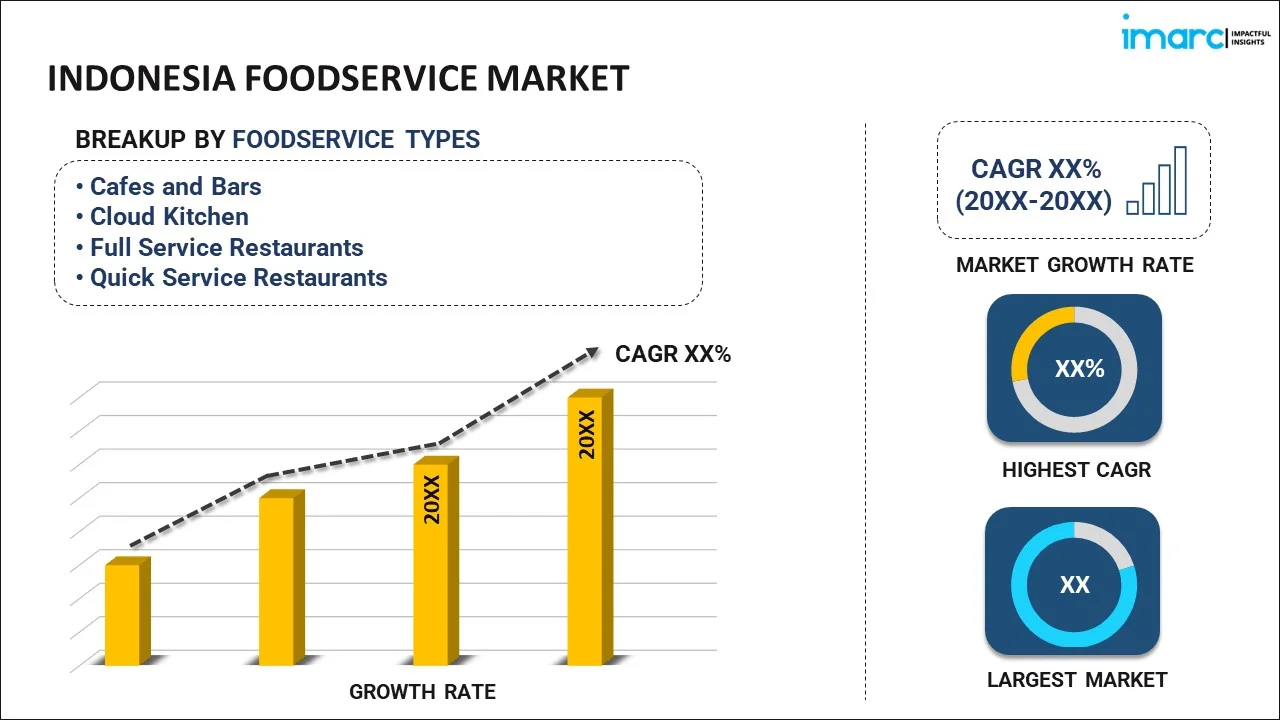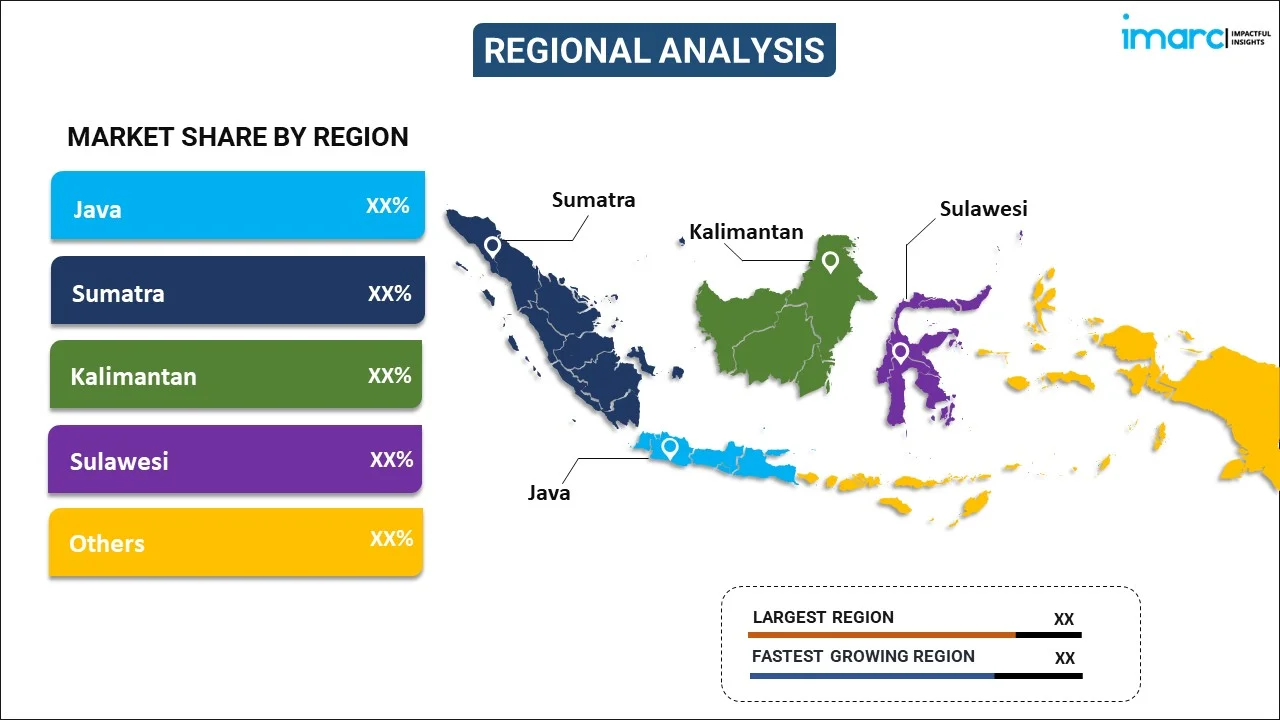
Indonesia Foodservice Market Report by Foodservice Type (Cafes and Bars, Cloud Kitchen, Full Service Restaurants, Quick Service Restaurants), Outlet (Chained Outlets, Independent Outlets), Location (Leisure, Lodging, Retail, Standalone, Travel), and Region 2024-2032
Market Overview:
Indonesia foodservice market size is projected to exhibit a growth rate (CAGR) of 12.15% during 2024-2032. The rising middle-class population across the region, changing consumer preferences, growth of e-commerce, growing tourism industry, favorable initiatives by the Indonesian government, and rising social media influence represent some of the key factors driving the market.
|
Report Attribute
|
Key Statistics
|
|---|---|
|
Base Year
|
2023 |
|
Forecast Years
|
2024-2032 |
|
Historical Years
|
2018-2023
|
| Market Growth Rate (2024-2032) | 12.15% |
Foodservice refers to the broad industry encompassing the preparation, distribution, and delivery of food and beverages to consumers. This industry plays a pivotal role in meeting the diverse dining needs of individuals across various settings, including restaurants, cafes, catering services, schools, hospitals, and more. Foodservice establishments can range from fine dining restaurants offering exquisite cuisine to fast-food chains providing quick and convenient meals. They typically offer a menu or list of food and beverage options for customers to choose from. Menus can range from simple to extensive, offering a wide variety of dishes and beverages to cater to diverse tastes. Another key aspect of the foodservice industry is its adaptability to changing consumer preferences and lifestyles. It continually evolves to meet demands for healthier options, convenience, and sustainability. Moreover, foodservice businesses are integral to the economy, contributing significantly to job creation and revenue generation.
Indonesia Foodservice Market Trends:
The expanding middle class population is one of the primary drivers of the foodservice market. As income levels increase, consumers have more disposable income to spend on dining out and exploring diverse culinary experiences. Additionally, rapid urbanization in Indonesia has led to a shift in lifestyle and dining habits. Urban areas often witness higher demand for convenience foods, quick-service restaurants, and food delivery services. Other than this, Indonesian consumers are becoming more health-conscious and seeking healthier food options. This has led to a surge in demand for restaurants and food outlets that offer nutritious and balanced meals. Besides this, the growth of e-commerce and smartphone penetration has revolutionized food delivery services in Indonesia. Apps and platforms for ordering food have become increasingly popular, providing consumers with convenience and a wide variety of choices. In line with this, the rich cultural diversity of the region has contributed to a vibrant food scene. Different regions in the country offer unique cuisines, and this diversity encourages experimentation and culinary innovation. Furthermore, Indonesia is a popular tourist destination, attracting visitors from around the world. The tourism industry drives demand for foodservice establishments, ranging from street food vendors to upscale restaurants. Apart from these factors, technology is playing an increasingly vital role in the foodservice market, from digital menus and contactless payment systems to kitchen automation, enhancing efficiency and customer experience. Moreover, government initiatives to promote the foodservice industry, such as reducing bureaucracy and streamlining regulations, have created a favorable business environment for food entrepreneurs, thus propelling the market.
Indonesia Foodservice Market Segmentation:
IMARC Group provides an analysis of the key trends in each segment of the market, along with forecasts at the country level for 2024-2032. Our report has categorized the market based on foodservice type, outlet, and location.
Foodservice Type Insights:

- Cafes and Bars
- Bars and Pubs
- Cafes
- Juice/Smoothie/Desserts Bars
- Specialist Coffee and Tea Shops
- Cloud Kitchen
- Full Service Restaurants
- Quick Service Restaurants
- Bakeries
- Burger
- Ice Cream
- Meat-based Cuisines
- Pizza
- Others
The report has provided a detailed breakup and analysis of the market based on the foodservice type. This includes cafes and bars (bars and pubs, cafes, juice/smoothie/desserts bars, and specialist coffee and tea shops), cloud kitchen, full service restaurants, quick service restaurants (bakeries, burger, ice cream, meat-based cuisines, pizza, and others).
Outlet Insights:
- Chained Outlets
- Independent Outlets
A detailed breakup and analysis of the market based on the outlet have also been provided in the report. This includes chained outlets and independent outlets.
Location Insights:
- Leisure
- Lodging
- Retail
- Standalone
- Travel
The report has provided a detailed breakup and analysis of the market based on the location. This includes leisure, lodging, retail, standalone, and travel.
Regional Insights:

- Java
- Sumatra
- Kalimantan
- Sulawesi
- Others
The report has also provided a comprehensive analysis of all the major regional markets, which include Java, Sumatra, Kalimantan, Sulawesi, and Others.
Competitive Landscape:
The market research report has also provided a comprehensive analysis of the competitive landscape in the market. Competitive analysis such as market structure, key player positioning, top winning strategies, competitive dashboard, and company evaluation quadrant has been covered in the report. Also, detailed profiles of all major companies have been provided.
Indonesia Foodservice Market Report Coverage:
| Report Features | Details |
|---|---|
| Base Year of the Analysis | 2023 |
| Historical Period | 2018-2023 |
| Forecast Period | 2024-2032 |
| Units | US$ Million |
| Scope of the Report | Exploration of Historical Trends and Market Outlook, Industry Catalysts and Challenges, Segment-Wise Historical and Future Market Assessment:
|
| Foodservice Types Covered |
|
| Outlets Covered | Chained Outlets, Independent Outlets |
| Locations Covered | Leisure, Lodging, Retail, Standalone, Travel |
| Regions Covered | Java, Sumatra, Kalimantan, Sulawesi, Others |
| Customization Scope | 10% Free Customization |
| Report Price and Purchase Option | Single User License: US$ 3699 Five User License: US$ 4699 Corporate License: US$ 5699 |
| Post-Sale Analyst Support | 10-12 Weeks |
| Delivery Format | PDF and Excel through Email (We can also provide the editable version of the report in PPT/Word format on special request) |
Key Questions Answered in This Report:
- How has the Indonesia foodservice Market performed so far and how will it perform in the coming years?
- What has been the impact of COVID-19 on the Indonesia foodservice Market?
- What is the breakup of the Indonesia foodservice Market on the basis of foodservice type?
- What is the breakup of the Indonesia foodservice Market on the basis of outlet?
- What is the breakup of the Indonesia foodservice Market on the basis of location?
- What are the various stages in the value chain of the Indonesia foodservice Market?
- What are the key driving factors and challenges in the Indonesia foodservice?
- What is the structure of the Indonesia foodservice Market and who are the key players?
- What is the degree of competition in the Indonesia foodservice Market?
Key Benefits for Stakeholders:
- IMARC’s industry report offers a comprehensive quantitative analysis of various market segments, historical and current market trends, market forecasts, and dynamics of the Indonesia foodservice Market from 2018-2032.
- The research report provides the latest information on the market drivers, challenges, and opportunities in the Indonesia foodservice Market.
- Porter's five forces analysis assist stakeholders in assessing the impact of new entrants, competitive rivalry, supplier power, buyer power, and the threat of substitution. It helps stakeholders to analyze the level of competition within the Indonesia foodservice industry and its attractiveness.
- Competitive landscape allows stakeholders to understand their competitive environment and provides an insight into the current positions of key players in the market.
Need more help?
- Speak to our experienced analysts for insights on the current market scenarios.
- Include additional segments and countries to customize the report as per your requirement.
- Gain an unparalleled competitive advantage in your domain by understanding how to utilize the report and positively impacting your operations and revenue.
- For further assistance, please connect with our analysts.
 Inquire Before Buying
Inquire Before Buying
 Speak to an Analyst
Speak to an Analyst
 Request Brochure
Request Brochure
 Request Customization
Request Customization




.webp)




.webp)












